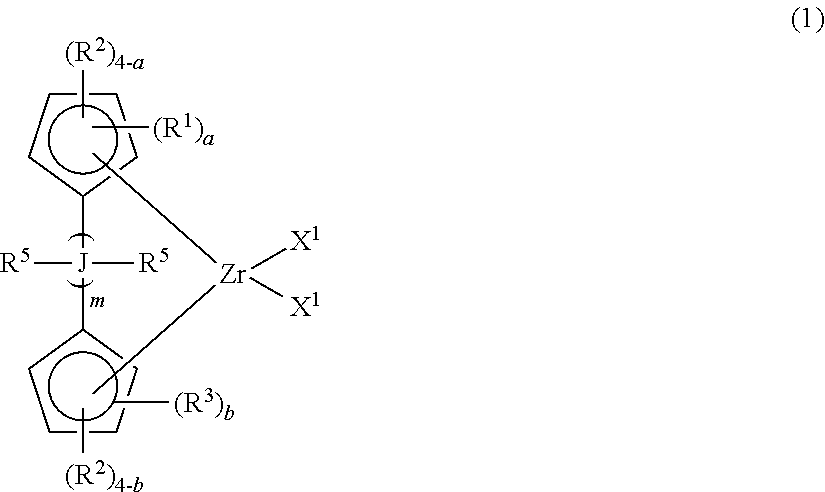Ethylene-alpha-olefin copolymer and molded object thereof
a technology of alpha-olefin and ethylene, which is applied in the direction of catalyst activation/preparation, physical/chemical process catalysts, chemical/physical processes, etc., can solve the problem of insufficient molding processability, and achieve the effect of small neck-in, short relaxation time, and high melt tension
- Summary
- Abstract
- Description
- Claims
- Application Information
AI Technical Summary
Benefits of technology
Problems solved by technology
Method used
Image
Examples
example 1
(1) Preparation of Solid Catalyst Component (B)
[0214]Into a reaction vessel substituted with nitrogen and equipped with a stirrer, 2.8 kg of heat-treated silica (Sylopol 948 manufactured by Davison Co.; 50% volume average particle diameter=55 μm; pore volume=1.67 ml / g; specific surface area=325 m2 / g) and 24 kg of toluene were charged and stirred at 300° C. under flow of nitrogen. After cooling the resultant mixture to 5° C., a mixed solution of 0.9 kg of 1,1,1,3,3,3-hexamethyldisilazane and 1.4 kg of toluene was added dropwise thereto over 30 minutes, while keeping the temperature of the reaction vessel at 5° C. After completion of dropping, stirring was conducted at 5° C. for 1 hour, then temperature was raised to 95° C., stirring was conducted at 95° C. for 3 hours, and filtration was conducted. The resultant solid product was washed 6 times with 20.8 kg of toluene. Thereafter, 7.1 kg of toluene was added thereto to produce a slurry, which was left at rest overnight.
[0215]Into the...
example 2
(1) Polymerization
[0217]After drying under reduced pressure, the inside of an autoclave with a stirrer having an inner volume of 3 L substituted with argon was made vacuum, hydrogen was added therein so as to give its partial pressure of 0.002 MPa, 100 ml of 1-hexene and 650 g of butane as a polymerization solvent were charged therein, and temperature was raised to 70° C. Thereafter, ethylene was added therein so as to give its partial pressure of 1.6 MPa and the inside of the system was made stable. As a result of gas chromatography analysis, the gas composition in the system indicated 0.09 mol % of hydrogen. Therein was charged 0.9 ml of a hexane solution of triisobutyl aluminium, which has a concentration adjusted at 1 mol / L, as an organic aluminium compound (C). Next, 1 ml of a toluene solution of dimethylsilylenebis(3-phenylcyclopentadienyl)zirconium dichloride (racemic / meso ratio=49.2 / 50.8) (A), which has a concentration adjusted at 1 μmol / ml, was charged therein, and sequenti...
example 3
(1) Polymerization
[0218]After drying under reduced pressure, the inside of an autoclave with a stirrer having an inner volume of 3 L substituted with argon was made vacuum, hydrogen was added therein so as to give its partial pressure of about 0.004 MPa, 100 ml of 1-hexene and 650 g of butane as a polymerization solvent were charged therein, and temperature was raised to 70° C. Thereafter, ethylene was added therein so as to give its partial pressure of 1.6 MPa and the inside of the system was made stable. As a result of gas chromatography analysis, the gas composition in the system indicated 0.17 mol % of hydrogen. Therein was charged 0.9 ml of a hexane solution of triisobutyl aluminium, which has a concentration adjusted at 1 mol / L, as an organic aluminium compound (C). Next, 1 ml of a toluene solution of dimethylsilylenebis(3-phenylcyclopentadienyl)zirconium dichloride (racemic / meso ratio=49.2 / 50.8) (A), which has a concentration adjusted at 1 μmol / ml, was charged therein, and se...
PUM
| Property | Measurement | Unit |
|---|---|---|
| activation energy | aaaaa | aaaaa |
| melt flow rate | aaaaa | aaaaa |
| melt flow rate | aaaaa | aaaaa |
Abstract
Description
Claims
Application Information
 Login to View More
Login to View More - R&D
- Intellectual Property
- Life Sciences
- Materials
- Tech Scout
- Unparalleled Data Quality
- Higher Quality Content
- 60% Fewer Hallucinations
Browse by: Latest US Patents, China's latest patents, Technical Efficacy Thesaurus, Application Domain, Technology Topic, Popular Technical Reports.
© 2025 PatSnap. All rights reserved.Legal|Privacy policy|Modern Slavery Act Transparency Statement|Sitemap|About US| Contact US: help@patsnap.com



